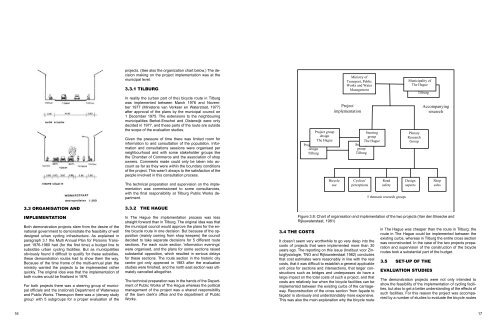Aalborg Universitet Bike Infrastructures Report Silva, Victor ... - VBN
Aalborg Universitet Bike Infrastructures Report Silva, Victor ... - VBN
Aalborg Universitet Bike Infrastructures Report Silva, Victor ... - VBN
You also want an ePaper? Increase the reach of your titles
YUMPU automatically turns print PDFs into web optimized ePapers that Google loves.
projects. (See also the organization chart below.) The decision<br />
making on the project implementation was at the<br />
municipal level.<br />
3.3.1 Tilburg<br />
In reality the (urban part of the) bicycle route in Tilburg<br />
was implemented between March 1976 and November<br />
1977 (Ministerie van Verkeer en Waterstaat, 1977)<br />
after approval of the plans by the municipal council on<br />
1 December 1975. The extensions to the neighbouring<br />
municipalities Berkel-Enschot and Oisterwijk were only<br />
decided in 1977, and these parts of the route are outside<br />
the scope of the evaluation studies.<br />
Given the pressure of time there was limited room for<br />
information to and consultation of the population. Information<br />
and consultations sessions were organised per<br />
neighbourhood and with some stakeholder groups like<br />
the Chamber of Commerce and the association of shop<br />
owners. Comments made could only be taken into account<br />
as far as they were within the boundary conditions<br />
of the project. This wasn’t always to the satisfaction of the<br />
people involved in this consultation process.<br />
The technical preparation and supervision on the implementation<br />
was commissioned to some consultancies,<br />
with the final responsibility at Tilburg Public Works department.<br />
Project group<br />
design<br />
The Hague<br />
Project group<br />
design<br />
Tilburg<br />
Ministry of<br />
Transport, Public<br />
Works and Water<br />
Management<br />
Project<br />
implementation<br />
Bicycle<br />
use<br />
Steering<br />
group<br />
The Hague<br />
Steering<br />
group<br />
Tilburg<br />
Cyclists’<br />
perceptions<br />
Road<br />
safety<br />
5 thematic research groups<br />
Municipality of<br />
The Hague<br />
Municipality of<br />
Tilburg<br />
Plenary<br />
Research<br />
Group<br />
Design<br />
aspects<br />
Accompanying<br />
research<br />
Shop<br />
sales<br />
3.3 Organisation and<br />
implementation<br />
Both demonstration projects stem from the desire of the<br />
national government to demonstrate the feasibility of well<br />
designed urban cycling infrastructure. As explained in<br />
paragraph 3.1 the Multi Annual Plan for Persons Transport<br />
1976-1980 had (for the first time) a budget line to<br />
subsidize urban cycling facilities. But as municipalities<br />
obviously found it difficult to qualify for these subsidies,<br />
these demonstration routes had to show them the way.<br />
Because of the time frame of the multi-annual plan the<br />
ministry wanted the projects to be implemented rather<br />
quickly. The original idea was that the implementation of<br />
both routes would be finalized in 1976.<br />
For both projects there was a steering group of municipal<br />
officials and the (national) Department of Waterways<br />
and Public Works. Thereupon there was a ‘plenary study<br />
group’ with 5 subgroups for a proper evaluation of the<br />
3.3.2 The Hague<br />
In The Hague the implementation process was less<br />
straight forward than in Tilburg. The original idea was that<br />
the municipal council would approve the plans for the entire<br />
bicycle route in one decision. But because of the opposition<br />
(mainly coming from shop keepers) the council<br />
decided to take separate decisions for 5 different route<br />
sections. For each route section ‘information evenings’<br />
were organised, and the plans for some sections raised<br />
substantial opposition, which resulted in serious delays<br />
for these sections. The route section in the historic city<br />
centre got only approved in 1983 after the evaluation<br />
studies were finished, and the north east section was ultimately<br />
cancelled altogether.<br />
The technical preparation was in the hands of the Department<br />
of Public Works of The Hague whereas the political<br />
management of the project was a shared responsibility<br />
of the town clerk’s office and the department of Public<br />
Works.<br />
3.4 The costs<br />
Figure 3.8: Chart of organisation and implementation of the two projects (Van den Broecke and<br />
Rijkswaterstaat, 1981)<br />
It doesn’t seem very worthwhile to go very deep into the<br />
costs of projects that were implemented more than 30<br />
years ago. The reporting on this issue (Instituut voor Zintuigfysiologie,<br />
TNO and Rijkswaterstaat 1982) concludes<br />
that cost estimates were reasonably in line with the real<br />
costs, that it was difficult to establish a general applicable<br />
unit price for sections and intersections, that larger constructions<br />
such as bridges and underpasses do have a<br />
large impact on the total costs of such a project, and that<br />
costs are relatively low when the bicycle facilities can be<br />
implemented between the existing curbs of the carriageway.<br />
Reconstruction of the cross section ‘from façade to<br />
façade’ is obviously and understandably more expensive.<br />
This was also the main explanation why the bicycle route<br />
in The Hague was cheaper than the route in Tilburg: the<br />
route in The Hague could be implemented between the<br />
existing curbs, whereas in Tilburg the entire cross section<br />
was reconstructed. In the case of the two projects preparation<br />
and supervision of the construction of the bicycle<br />
routes took a substantial part of the budget.<br />
3.5 Set-up of the<br />
evaluation studies<br />
The demonstration projects were not only intended to<br />
show the feasibility of the implementation of cycling facilities,<br />
but also to get a better understanding of the effects of<br />
such facilities. For this reason the project was accompanied<br />
by a number of studies to evaluate the bicycle routes<br />
16 17
















